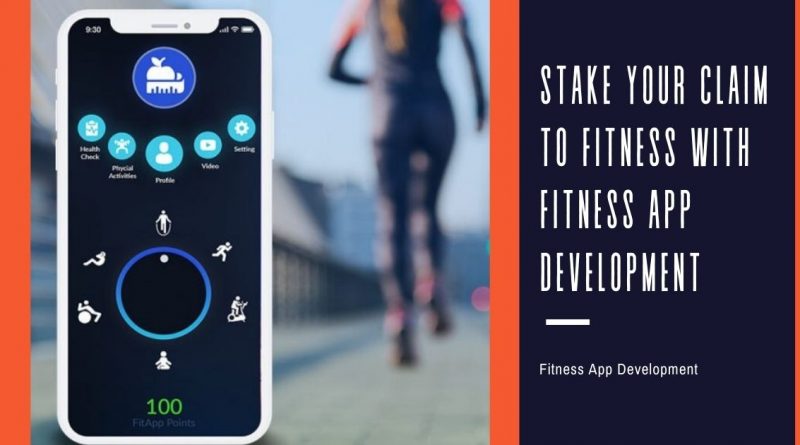Stake Your Claim To Fitness With Fitness App Development
Fitness is the new fad. People have realized that health is wealth and have adopted some new habits to boost their health. One of them is using a fitness app to ensure that you are in the pink of your health. Statistics show that the global fitness and health club industry is worth over $80 billion. As a result of people turning more health-conscious, fitness franchisees seem to have mushroomed all over the place. A lot of other factors also play a role in the enlargement of fitness brands. Some of them are as follows, increased popularity of gym culture, a shift from budget-friendly gyms, etc.
Leverage this and earn stunning returns by developing your own app with fitness app development. But before you take the plunge, you need to decide what type of fitness app you would like to create. To make the process easier for you, it is explained below
Types of fitness apps
To create a fitness app, you have to choose what type of app you want. There are generally three types of fitness apps-activity tracking app, diet and nutrition app, and workout and exercise app. Each app is filled with features like tracking your result, calculating the steps you took, etc. They are explained elaborately below,
Activity tracking apps
In this, the apps track the user’s physical activity. Like for example, the number of steps you’ve taken, stairs climbed, hours you’ve slept, distance traveled and the speed at which you’ve walked, etc.
Diet and nutrition apps
These apps monitor one’s food habits, the number of calories burnt or taken, water balance in their body, body weight, and so on. Some advanced apps also allow users to set their own goals, even curate recipes to suit their objectives.
Workout and exercise apps
A workout application does the same job as a personal trainer, albeit virtually. Some apps also allow you to choose your trainer and the level of physical exercise you need according to your goal. Some apps calculate the BMI and help you to reduce the hip-waist ratio or get abs. Users can choose which part of the body they want to work out first. Some of the options include Full Body, Upper Body, Core Strength, Lower Body, and Custom Workout.
Some apps have an inbuilt timer to let you know the time you take to complete an exercise. If the exercise is not clear, the user can see a visual representation of the exercise through a video and then continue working out. It also has the option to share your achievements and goals with your friends to enhance your motivation.
How to develop your fitness application
There are a few steps you can follow to develop your own efficient and robust fitness application. If you want to turn your business idea about a fitness app into a reality, follow the steps described below:
Decide on the revenue model:
The several revenue models are explained below; you can choose any one of them,
Freemium: The basic app can be used free of charge, but if they want additional features or premium features, they are charged a small sum of money
Paid apps: users should buy your app before using it. The app price can be varied based on the mobile platform, the content you provide, etc.
Advertisements: charge ads for placing an ad on your app. You can charge a cost-per-click or a cost-per-mile commission.
Sponsored content: by partnering with fitness experts and gyms and providing their content to the users, you can earn revenue.
Decide on the features you want in your app.
The basic features that are necessary for the efficient functioning of your app are:
User profile:
User can create a user profile easily by providing mobile number details, email address, or social media credentials. It gives users the option to track their goals and keep a record of their achievements. Physical characteristics like height, weight, etc., can also be saved to curate content and workout for the user.
Notifications:
To motivate the user to be more fit, push notifications are inevitable. They remind users about the workout and their goals. If they’ve missed an activity, they can be notified through these in-app alerts.
Keep an account of physical activity: Users can keep track of their physical activity by connecting the app with the phone’s sensors. It provides valuable insights into oneself.
Social sharing:
Giving users an option to share their results and achievements.
Geolocation:
Option to see how many kilometers you’ve walked or cycled, it can also be compared to the earlier day, which will give you massive self-satisfaction.
Choose a development team
To make your fitness app, you have to hire a fitness app development team to analyze your business needs and requirements and provide a white-label and scalable solution.
Beginning stage
In this stage, along with your fitness app development company, you have to define the scope of work required for your project, create a guideline, and plan the resources and the budget required. It takes around 4-6 weeks to complete. It includes creating UX/UI design and a visual prototype of your app to give you a clear vision of the end product.
Technical documentation
A technical writer is a person who prepares the product’s technical specifications based on the client’s requirements. It includes various details about the platforms, and all other required information for the fitness app developer to start working out the solutions.
Design
Any design team needs a minimum of around two months (160 hours) to create a fantastic fitness app – both UX and UI parts. Again, to create your workout app design, the cost depends on the requirements – whether you need only standard features, premium, or custom micro-interactions.
Workout application development
For launching an app for Android and iOS, at least three developers are required.
Quality assurance
It’s mandatory to ensure that the app is free of bugs and is up and running takes a fair bit of time. Apart from checking the code for bugs, Quality analyst engineers test the project’s overall user experience and whether the features work as they are expected to.
Cost of making a fitness app
It depends on various factors like the app’s type, complexity, design, features incorporated, etc. The total cost of fitness app development depends on the time and the number of developers involved in the project. On average, it takes around four months to develop an app. However, it can also vary based on the app’s features, target platforms, type of app, etc.
Conclusion
Developing a fitness application can be a daunting task. But having explained all the necessary features and a guide to developing an app, I hope that it will make your journey to create a fitness app easier.
A few things to summarize:
Your app should be filled with the best fitness app features such as personal accounts, setting goals, activity tracking, etc. The app can provide customized workout plans. Using gamification elements in your app allures the users to use your app often and share it with their friends. E.g., run keeper, to conclude, finally, create a fitness app minimum viable product (MVP) to save money, time, and get immediate feedback from customers. Good luck!




